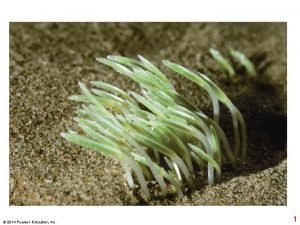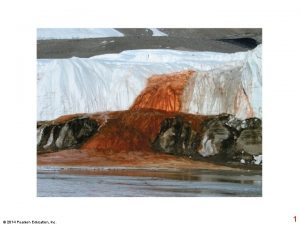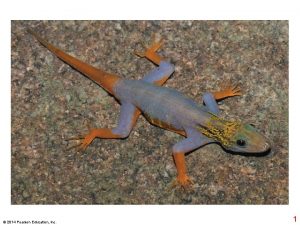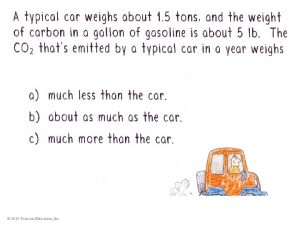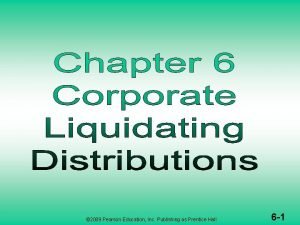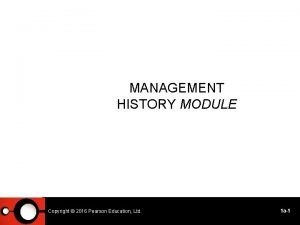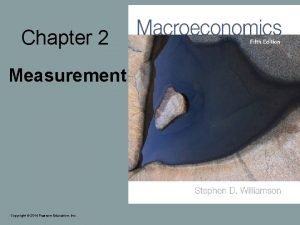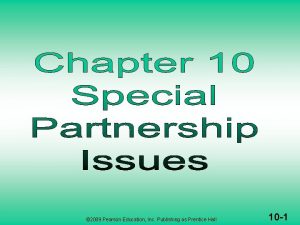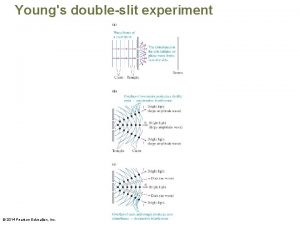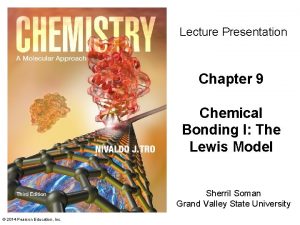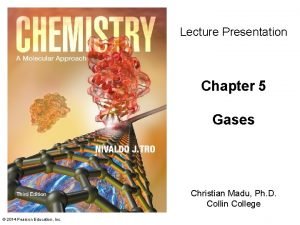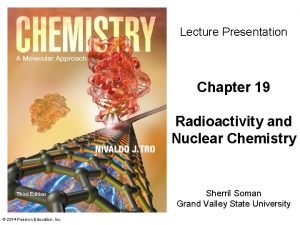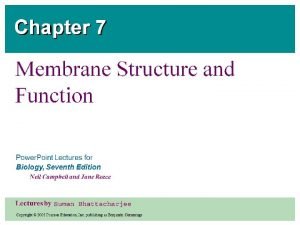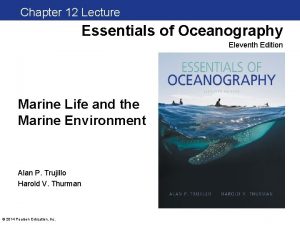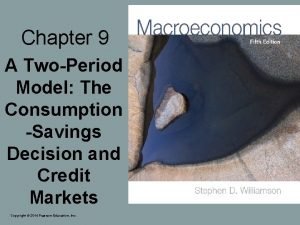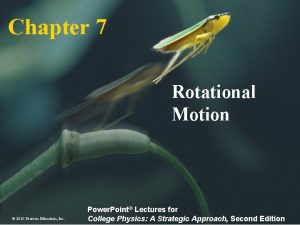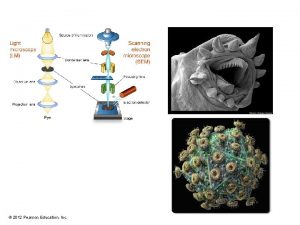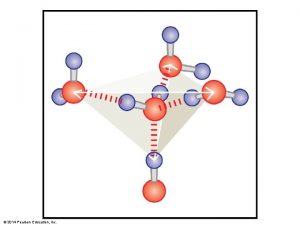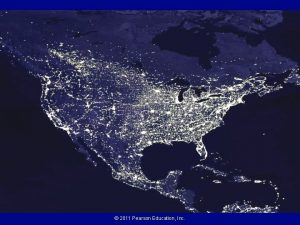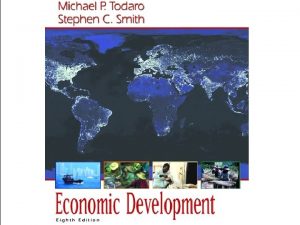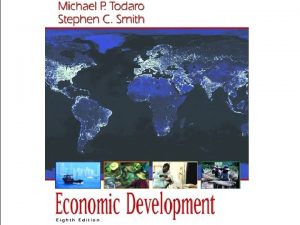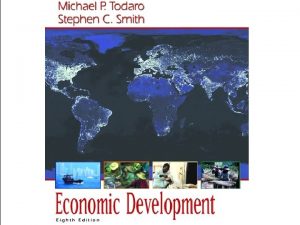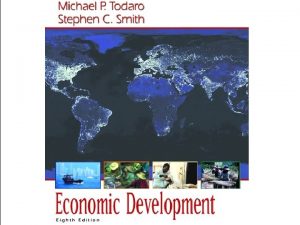Chapter 3 Cells Copyright 2003 Pearson Education Inc










































































































- Slides: 106

Chapter 3 Cells Copyright © 2003 Pearson Education, Inc. publishing as Benjamin Cummings

Cells · What are the different structures and functions of the cells that make up the body? Copyright © 2003 Pearson Education, Inc. publishing as Benjamin Cummings Slide 3. 1

Cells– C, O, H, N · Carry out all chemical activities needed to sustain life. · Building blocks of all living things · Tissues- groups of cells that are similar in structure and function · Structure reflects function Copyright © 2003 Pearson Education, Inc. publishing as Benjamin Cummings Slide 3. 1

Anatomy of the Generalized Cell · Cells are not all the same · All cells share general structures · Three main regions · Nucleus · Cytoplasm · Plasma membrane Figure 3. 1 a Copyright © 2003 Pearson Education, Inc. publishing as Benjamin Cummings Slide 3. 2

The Nucleus · Control center · Genetic material (DNA) · Three regions · Nuclear membrane · Nucleolus · Chromatin Figure 3. 1 b Copyright © 2003 Pearson Education, Inc. publishing as Benjamin Cummings Slide 3. 3

Nuclear Membrane – double membrane or envelope · Barrier of nucleus · Double phospholipid membrane · Nuclear pores that allow for exchange of material with the rest of the cell – selectively permeable Copyright © 2003 Pearson Education, Inc. publishing as Benjamin Cummings Slide 3. 4

Figure 3. 29 b The nucleus. Surface of nuclear envelope. Fracture line of outer membrane Nuclear pores Nucleus Nuclear pore complexes. Each pore is ringed by protein particles. Nuclear lamina. The netlike lamina composed of intermediate filaments formed by lamins lines the inner surface of the nuclear envelope.

Nucleoli · 1 or more · Sites of ribosome production · Ribosomes then migrate to the cytoplasm through nuclear pores Copyright © 2003 Pearson Education, Inc. publishing as Benjamin Cummings Slide 3. 5

Chromatin (when not dividing) · Composed of DNA and protein · Scattered throughout the nucleus · Condenses to form chromosomes when the cell divides Copyright © 2003 Pearson Education, Inc. publishing as Benjamin Cummings Slide 3. 6

Figure 3. 30 Chromatin and chromosome structure. 1 DNA double helix (2 -nm diameter) Histones 2 Chromatin (“beads on a string”) structure with nucleosomes Linker DNA Nucleosome (10 -nm diameter; eight histone proteins wrapped by two winds of the DNA double helix) 3 Tight helical fiber (30 -nm diameter) 4 Looped domain structure (300 -nm 5 Chromatid diameter) (700 -nm diameter) 6 Metaphase chromosome (at midpoint of cell division) consists of two sister chromatids

Plasma Membrane · Barrier for cell contents · Double phospholipid layer (fat – water) · Hydrophilic heads · Hydrophobic tails · Other materials in plasma membrane · Protein · Cholesterol · Glycoproteins Copyright © 2003 Pearson Education, Inc. publishing as Benjamin Cummings Slide 3. 7 a

Plasma Membrane Figure 3. 2 Copyright © 2003 Pearson Education, Inc. publishing as Benjamin Cummings Slide 3. 7 b

Plasma Membrane · Lipid bilayer and proteins in constantly changing fluid mosaic · Plays dynamic role in cellular activity · Separates intracellular fluid (ICF) from extracellular fluid (ECF) · Interstitial fluid (IF) = ECF that surrounds cells Copyright © 2003 Pearson Education, Inc. publishing as Benjamin Cummings Slide 3. 7 a

Figure 3. 3 The plasma membrane. Extracellular fluid (watery environment outside cell) Polar head of phospholipid molecule Nonpolar tail of phospholipid molecule Cholesterol Glycolipid Glycocalyx (carbohydrates) Lipid bilayer containing proteins Outward-facing layer of phospholipids Inward-facing layer of phospholipids Cytoplasm (watery environment inside cell) Integral Filament of Peripheral proteins cytoskeleton proteins Glycoprotein

Membrane Lipids · 75% phospholipids (lipid bilayer) · Phosphate heads: polar and hydrophilic · Fatty acid tails: nonpolar and hydrophobic (Review Fig. 2. 16 b) · 5% glycolipids · Lipids with polar sugar groups on outer membrane surface · 20% cholesterol · Increases membrane stability Copyright © 2003 Pearson Education, Inc. publishing as Benjamin Cummings Slide 3. 7 a

Membrane Proteins · Allow communication with environment · ½ mass of plasma membrane · Most specialized membrane functions · Some float freely · Some tethered to intracellular structures · Two types: · Integral proteins; peripheral proteins Copyright © 2003 Pearson Education, Inc. publishing as Benjamin Cummings Slide 3. 7 a

Figure 3. 3 The plasma membrane. Extracellular fluid (watery environment outside cell) Polar head of phospholipid molecule Nonpolar tail of phospholipid molecule Cholesterol Glycolipid Glycocalyx (carbohydrates) Lipid bilayer containing proteins Outward-facing layer of phospholipids Inward-facing layer of phospholipids Cytoplasm (watery environment inside cell) Integral Filament of Peripheral proteins cytoskeleton proteins Glycoprotein

Six functions of Membrane Proteins 1. Transport 2. Receptors for signal transduction 3. Attachment to cytoskeleton and extracellular matrix 4. Enzymatic activity 5. Intercellular joining 6. Cell-cell recognition Copyright © 2003 Pearson Education, Inc. publishing as Benjamin Cummings Slide 3. 7 a

Figure 3. 4 a Membrane proteins perform many tasks. Transport • A protein (left) that spans the membrane may provide a hydrophilic channel across the membrane that is selective for a particular solute. • Some transport proteins (right) hydrolyze ATP as an energy source to actively pump substances across the membrane. PLAY Animation: Transport Proteins

Figure 3. 4 b Membrane proteins perform many tasks. Signal Receptor PLAY Receptors for signal transduction • A membrane protein exposed to the outside of the cell may have a binding site that fits the shape of a specific chemical messenger, such as a hormone. • When bound, the chemical messenger may cause a change in shape in the protein that initiates a chain of chemical reactions in the cell. Animation: Receptor Proteins

Figure 3. 4 c Membrane proteins perform many tasks. Attachment to the cytoskeleton and extracellular matrix • Elements of the cytoskeleton (cell's internal supports) and the extracellular matrix (fibers and other substances outside the cell) may anchor to membrane proteins, which helps maintain cell shape and fix the location of certain membrane proteins. • Others play a role in cell movement or bind adjacent cells together.

Figure 3. 4 d Membrane proteins perform many tasks. Enzymatic activity Enzymes PLAY • A membrane protein may be an enzyme with its active site exposed to substances in the adjacent solution. • A team of several enzymes in a membrane may catalyze sequential steps of a metabolic pathway as indicated (left to right) here. Animation: Enzymes

Figure 3. 4 e Membrane proteins perform many tasks. Intercellular joining • Membrane proteins of adjacent cells may be hooked together in various kinds of intercellular junctions. • Some membrane proteins (cell adhesion molecules or CAMs) of this group provide temporary binding sites that guide cell migration and other cell-to-cell interactions. CAMs

Figure 3. 4 f Membrane proteins perform many tasks. Cell-cell recognition • Some glycoproteins (proteins bonded to short chains of sugars) serve as identification tags that are specifically recognized by other cells. Glycoprotein

Glycocalyx · "Sugar covering" at cell surface · Lipids and proteins with attached carbohydrates (sugar groups) · Every cell type has different pattern of sugars · Specific biological markers for cell to cell recognition · Allows immune system to recognize "self" and "non self" · Cancerous cells change it continuously Copyright © 2003 Pearson Education, Inc. publishing as Benjamin Cummings Slide 3. 7 a

Plasma Membrane Specializations · Microvilli · Finger-like projections · Increase surface area for absorption · Small intestine and nephrons of kidney Figure 3. 3 Copyright © 2003 Pearson Education, Inc. publishing as Benjamin Cummings Slide 3. 8 a

Figure 3. 28 Microvilli. Microvillus Actin filaments Terminal web

Cytoplasm · Material outside the nucleus and inside the plasma membrane · Cytosol · Fluid that suspends other elements · Organelles · Metabolic machinery of the cell · Inclusions · Non-functioning units – fat, pigments…. . Copyright © 2003 Pearson Education, Inc. publishing as Benjamin Cummings Slide 3. 9

Cytoplasmic Organelles Figure 3. 4 Copyright © 2003 Pearson Education, Inc. publishing as Benjamin Cummings Slide 3. 10

Cytoplasmic Organelles · Membranous · Nonmembranous · Mitochondria · Cytoskeleton · Peroxisomes · Centrioles · Lysosomes · Ribosomes · Endoplasmic reticulum · Golgi apparatus • Membranes allow crucial compartmentalization Copyright © 2003 Pearson Education, Inc. publishing as Benjamin Cummings Slide 3. 15

Cytoplasmic Organelles · Mitochondria · “Powerhouses” of the cell · Double-membrane structure with inner shelflike cristae: Change shape continuously · Carry out reactions where oxygen is used to break down food · Provides ATP for cellular energy · Contain their own DNA, RNA, ribosomes · Similar to bacteria; capable of cell division called fission Copyright © 2003 Pearson Education, Inc. publishing as Benjamin Cummings Slide 3. 15

Figure 3. 17 Mitochondrion. Outer mitochondrial membrane Ribosome Mitochondrial DNA Inner mitochondrial membrane Cristae Matrix Enzymes

Cytoplasmic Organelles · Ribosomes · Made of protein and RNA · Protein synthesis · Two locations · Free in the cytoplasm · Attached to rough endoplasmic reticulum Copyright © 2003 Pearson Education, Inc. publishing as Benjamin Cummings Slide 3. 11

Cytoplasmic Organelles · Endoplasmic reticulum (ER) · Fluid-filled tubules for carrying substances · Two types of ER · Rough Endoplasmic Reticulum · Studded with ribosomes · Site where building materials of cellular membrane are formed (leave the cell) · Smooth Endoplasmic Reticulum · Functions in cholesterol synthesis and breakdown, fat metabolism, and detoxification of drugs, glycogen conversion, store and release Ca 2+ Slide 3. 12 Copyright © 2003 Pearson Education, Inc. publishing as Benjamin Cummings

Figure 3. 18 The endoplasmic reticulum. Nucleus Smooth ER Nuclear envelope Rough ER Ribosomes Diagrammatic view of smooth and rough ER Electron micrograph of smooth and rough ER (25, 000 x)

Cytoplasmic Organelles · Golgi apparatus · Stacked and flattened membranous sacs · Modifies, concentrates, and packages proteins and lipids from rough ER Copyright © 2003 Pearson Education, Inc. publishing as Benjamin Cummings Slide 3. 13 a

Figure 3. 19 a Golgi apparatus. Transport vesicle from rough ER Cis face— “receiving” side of Golgi apparatus Cisterns New vesicles forming Transport vesicle from trans face Secretory vesicle Trans face— “shipping” side of Golgi apparatus Many vesicles in the process of pinching off from the Golgi apparatus.

Figure 3. 19 b Golgi apparatus. New vesicles forming Transport vesicle at Golgi the trans face apparatus Electron micrograph of the Golgi apparatus (90, 000 x)

Figure 3. 20 The sequence of events from protein synthesis on the rough ER to the final distribution of those proteins. 1 Protein-conta- Rough ER ining vesicles pinch off rough ER and migrate to fuse with membranes of Golgi apparatus. ER membrane Proteins in cisterns Slide 2 Plasma membrane Golgi apparatus Extracellular fluid

Figure 3. 20 The sequence of events from protein synthesis on the rough ER to the final distribution of those proteins. 1 Protein-conta- Rough ER ining vesicles pinch off rough ER and migrate to fuse with membranes of Golgi apparatus. ER membrane Proteins in cisterns Slide 3 Plasma membrane 2 Proteins are modified within the Golgi compartments. Golgi apparatus Extracellular fluid

Figure 3. 20 The sequence of events from protein synthesis on the rough ER to the final distribution of those proteins. 1 Protein-conta- Rough ER ining vesicles pinch off rough ER and migrate to fuse with membranes of Golgi apparatus. ER Phagosome membrane Proteins in cisterns 2 Proteins are modified within the Golgi compartments. 3 Proteins are then packaged within different vesicle types, depending on their ultimate destination. Vesicle becomes lysosome Golgi apparatus Pathway A: Vesicle contents destined for exocytosis Secretory vesicle Secretion by exocytosis Slide 4 Plasma membrane Pathway C: Lysosome containing acid hydrolase enzymes Pathway B: Vesicle membrane to be incorporated into plasma membrane Extracellular fluid

Cytoplasmic Organelles · Lysosomes · Contain enzymes that digest non-usable materials within the cell or “foreign” or toxic materials · Peroxisomes · Membranous sacs of oxidase and catalase enzymes · Detoxify harmful substances · Break down free radicals (highly reactive chemicals) · Catalyze and synthesize fatty acids · Replicate by pinching in half Copyright © 2003 Pearson Education, Inc. publishing as Benjamin Cummings Slide 3. 14

Figure 3. 21 Electron micrograph of lysosomes (20, 000 x). Lysosomes Light green areas are regions where materials are being digested.

Cytoplasmic Organelles · Cytoskeleton · Network of protein structures that extend throughout the cytoplasm · Provides the cell with an internal framework Copyright © 2003 Pearson Education, Inc. publishing as Benjamin Cummings Slide 3. 16 a

Cytoplasmic Organelles · Cytoskeleton · Three different types · Microfilaments · Intermediate filaments · Microtubules Figure 3. 6 Copyright © 2003 Pearson Education, Inc. publishing as Benjamin Cummings Slide 3. 16 b

Figure 3. 23 a Cytoskeletal elements support the cell and help to generate movement. Microfilaments Tough, insoluble protein fibers constructed like woven ropes composed of tetramer (4) fibrils · Gives strength, compression resistance Tetramer subunits 10 nm · Involved in cell motility, change in shape, endocytosis and exocytosis Microfilaments form the blue batlike network in this photo.

Figure 3. 23 b Cytoskeletal elements support the cell and help to generate movement. Intermediate filaments Strands made of spherical protein subunits called actins • Resist pulling forces on cell; attach to desmosomes Actin subunit 7 nm • E. g. , neurofilaments in nerve cells; keratin filaments in epithelial cells Intermediate filaments form the purple network surrounding the pink nucleus in this photo.

Figure 3. 23 c Cytoskeletal elements support the cell and help to generate movement. Microtubules Hollow tubes of spherical protein subunits called tubulins • Determine overall shape of cell and distribution of organelles Tubulin subunits 25 nm • Mitochondria, lysosomes, secretory vesicles attach to microtubules; moved throughout cell by motor proteins Microtubules appear as gold networks surrounding the cells’ pink nuclei in this photo.

Figure 3. 24 Microtubules and microfilaments function in cell motility by interacting with motor molecules powered by ATP. Vesicle Receptor for motor molecule Motor molecule (ATP powered) Microtubule of cytoskeleton Motor molecules can attach to receptors on vesicles or organelles, and carry the organelles along the microtubule “tracks” of the cytoskeleton. Motor molecule (ATP powered) Cytoskeletal elements (microtubules or microfilaments) In some types of cell motility, motor molecules attached to one element of the cytoskeleton cause it to slide over another element, which the motor molecules grip, release, and grip at a new site. Muscle contraction and cilia movement work this way.

Cytoplasmic Organelles · Centrosome Contains paired Centrioles · Rod-shaped bodies made of microtubules · Direct formation of mitotic spindle during cell division · Centrioles form basis of cilia and flagella Copyright © 2003 Pearson Education, Inc. publishing as Benjamin Cummings Slide 3. 17

Figure 3. 25 a Centrioles. Centrosome matrix Centrioles Microtubules

Figure 3. 25 b Centrioles.

Cellular Projections · Not found in all cells · Used for movement · Cilia moves materials across the cell surface · Flagellum propels the cell Copyright © 2003 Pearson Education, Inc. publishing as Benjamin Cummings Slide 3. 18

Cellular Diversity What are the different sizes, shapes and functions of human cells? Copyright © 2003 Pearson Education, Inc. publishing as Benjamin Cummings Slide 3. 18

Cell Diversity Figure 3. 7; 1, 2 Copyright © 2003 Pearson Education, Inc. publishing as Benjamin Cummings Slide 3. 19 a

Cell Diversity Figure 3. 7; 1, 2 Copyright © 2003 Pearson Education, Inc. publishing as Benjamin Cummings Slide 3. 19 a

Cell Diversity Figure 3. 7; 3 Copyright © 2003 Pearson Education, Inc. publishing as Benjamin Cummings Slide 3. 19 b

Cell Diversity Figure 3. 7; 3 Copyright © 2003 Pearson Education, Inc. publishing as Benjamin Cummings Slide 3. 19 b

Cell Diversity Figure 3. 7; 4, 5 Copyright © 2003 Pearson Education, Inc. publishing as Benjamin Cummings Slide 3. 19 c

Cell Diversity Figure 3. 7; 4, 5 Copyright © 2003 Pearson Education, Inc. publishing as Benjamin Cummings Slide 3. 19 c

Cell Diversity Figure 3. 7; 4, 5 Copyright © 2003 Pearson Education, Inc. publishing as Benjamin Cummings Slide 3. 19 c

Cell- Size range • Diameter: 10 µm to 100 µm • Length: 5 µm to 1 meter • How big is a micrometer? ? • µm = micrometer = 10^-6 meters • µm = 1 thousandth of a millimeter

Variety of cell shapes • Spherical • fat cells • Disk-shaped • RBC’s • Branched • Nerve Cells • Cube-like • Epithelial cells

Membrane Transport · How do substances enter and exit the cell? Copyright © 2003 Pearson Education, Inc. publishing as Benjamin Cummings Slide 3. 20

Cellular Physiology: Membrane Transport · Membrane Transport – movement of substance into and out of the cell · Two basic methods 1. Passive transport · No energy required (diffusion, osmosis, filtration) 2. Active transport (solute pumping, bulk) · Uses metabolic energy Copyright © 2003 Pearson Education, Inc. publishing as Benjamin Cummings Slide 3. 20

Selective Permeability · Plasma membrane allows some materials to pass while excluding others · Includes movement into and out of the cell Copyright © 2003 Pearson Education, Inc. publishing as Benjamin Cummings Slide 3. 22

Passive Transport Processes · Diffusion · Particles distribute themselves evenly · Movement from high to low concentration · Types · Osmosis (water) · Facilitated (proteins) Figure 3. 8 Copyright © 2003 Pearson Education, Inc. publishing as Benjamin Cummings Slide 3. 23

Diffusion through the Plasma Membrane Copyright © 2003 Pearson Education, Inc. publishing as Benjamin Cummings Slide 3. 25

Tonicity • Tonicity: Ability of solution to alter cell's water volume • Isotonic: Solution with same non-penetrating solute concentration as cytosol • Hypertonic: Solution with higher non-penetrating solute concentration than cytosol • Hypotonic: Solution with lower non-penetrating solute concentration than cytosol

Figure 3. 9 The effect of solutions of varying tonicities on living red blood cells. Isotonic solutions Cells retain their normal size and shape in isotonic solutions (same solute/water concentration as inside cells; water moves in and out). Hypertonic solutions Cells lose water by osmosis and shrink in a hypertonic solution (contains a higher concentration of solutes than are present inside the cells). Hypotonic solutions Cells take on water by osmosis until they become bloated and burst (lyse) in a hypotonic solution (contains a lower concentration of solutes than are present inside cells).

Passive Transport Processes · Filtration · Water and solutes are forced through a membrane by fluid, or hydrostatic pressure · A pressure gradient must exist Copyright © 2003 Pearson Education, Inc. publishing as Benjamin Cummings Slide 3. 26

Active Transport Processes · Solute Pumping · Against concentration gradient · Sodium-Potassium Pump Copyright © 2003 Pearson Education, Inc. publishing as Benjamin Cummings Slide 3. 30 a

Active Transport Processes · Bulk transport (vesicles) · Exocytosis · Moves material out of cell · Endocytosis · Bringing material into cell · Phagocytosis – cell eating · Pinocytosis – cell drinking Copyright © 2003 Pearson Education, Inc. publishing as Benjamin Cummings Slide 3. 30 a

Active Transport Processes Figure 3. 11 Copyright © 2003 Pearson Education, Inc. publishing as Benjamin Cummings Slide 3. 29 b

Active Transport Processes Figure 3. 12 opyright © 2003 Pearson Education, Inc. publishing as Benjamin Cummings Slide 3. 30 b

Figure 3. 13 a Comparison of three types of endocytosis. Receptors Phagosome Phagocytosis The cell engulfs a large particle by forming projecting pseudopods ("false feet") around it and enclosing it within a membrane sac called a phagosome. The phagosome is combined with a lysosome. Undigested contents remain in the vesicle (now called a residual body) or are ejected by exocytosis. Vesicle may or may not be protein coated but has receptors capable of binding to microorganisms or solid particles.

Figure 3. 13 b Comparison of three types of endocytosis. Pinocytosis The cell "gulps" a drop of extracellular fluid containing solutes into tiny vesicles. No receptors are used, so the process is nonspecific. Most vesicles are protein-coated. Vesicle

Figure 3. 14 Exocytosis. Slide 1 The process of exocytosis Plasma membrane Extracellular SNARE (t-SNARE) fluid Secretory vesicle Vesicle SNARE (v-SNARE) Molecule to be secreted Cytoplasm Fused v- and t-SNAREs Fusion pore formed 1 The membranebound vesicle migrates to the plasma membrane. 2 There, proteins at the vesicle surface (v -SNAREs) bind with t -SNAREs (plasma membrane proteins). 3 The vesicle and plasma membrane fuse and a pore opens up. 4 Vesicle contents are released to the cell exterior.

Figure 3. 14 b Exocytosis. Photomicrograph of a secretory vesicle releasing its contents by exocytosis (100, 000 x)

Cell Life Cycle · How do cells reproduce? Copyright © 2003 Pearson Education, Inc. publishing as Benjamin Cummings Slide 3. 31

Figure 3. 31 The cell cycle. G 1 checkpoint (restriction point) S Growth and DNA synthesis G 1 Growth M se ha ap et M se pha Ana Telopha se Cy t ok i G 2 Growth and final preparations for division Pr is ne s op ha se G 2 checkpoint

Cell Life Cycle · Cells have two major periods · Interphase · Cell grows · Cell carries on metabolic processes · Cell division · Cell replicates itself · Function is to produce more cells for growth and repair processes Copyright © 2003 Pearson Education, Inc. publishing as Benjamin Cummings Slide 3. 31

Interphase · Period from cell formation to cell division · Nuclear material called chromatin · Three subphases: · G 1 (gap 1)—vigorous growth and metabolism · Cells that permanently cease dividing said to be in G 0 phase · S (synthetic)—DNA replication occurs · G 2 (gap 2)—preparation for division Copyright © 2003 Pearson Education, Inc. publishing as Benjamin Cummings Slide 3. 31

Events of Cell Division · Mitosis (PMAT) · Division of the nucleus · Results in the formation of two daughter nuclei · Cytokinesis · Division of the cytoplasm · Results in the formation of two daughter cells Copyright © 2003 Pearson Education, Inc. publishing as Benjamin Cummings Slide 3. 33

Stages of Mitosis Centrioles Chromatin Plasma membrane Nuclear envelope Nucleolus Interphase Figure 3. 15, step 1

Stages of Mitosis Centrioles Plasma membrane Interphase Chromatin Forming mitotic spindle Nuclear envelope Nucleolus Centromere Chromosome, consisting of two sister chromatids Early prophase Figure 3. 15, step 2

Stages of Mitosis Centrioles Plasma membrane Interphase Chromatin Forming mitotic spindle Nuclear envelope Nucleolus Chromosome, consisting of two sister chromatids Early prophase Centromere Spindle microtubules Centromere Fragments of nuclear envelope Spindle pole Late prophase Figure 3. 15, step 3

Stages of Mitosis Spindle Metaphase plate Sister chromatids Metaphase Figure 3. 15, step 4

Stages of Mitosis Spindle Metaphase plate Sister chromatids Metaphase Daughter chromosomes Anaphase Figure 3. 15, step 5

Stages of Mitosis Spindle Nucleolus forming Metaphase plate Cleavage furrow Sister chromatids Metaphase Daughter chromosomes Anaphase Nuclear envelope forming Telophase and cytokinesis Figure 3. 15, step 6

Figure 3. 33 Mitosis is the process of nuclear division in which the chromosomes are distributed to two daughter nuclei. (2 of 6) Early Prophase Early mitotic spindle Aster Chromosome consisting of two sister chromatids Centromere

Figure 3. 33 Mitosis is the process of nuclear division in which the chromosomes are distributed to two daughter nuclei. (3 of 6) Late Prophase Spindle pole Polar microtubule Fragments of nuclear envelope Kinetochore microtubule

Figure 3. 33 Mitosis is the process of nuclear division in which the chromosomes are distributed to two daughter nuclei. (4 of 6) Metaphase Spindle Metaphase plate

Figure 3. 33 Mitosis is the process of nuclear division in which the chromosomes are distributed to two daughter nuclei. (5 of 6) Anaphase Daughter chromosomes

Figure 3. 33 Mitosis is the process of nuclear division in which the chromosomes are distributed to two daughter nuclei. (6 of 6) Telophase Cytokinesis Nuclear envelope forming Nucleolus forming Contractile ring at cleavage furrow

Protein Synthesis · Gene – DNA segment that carries a blueprint for building one protein · Proteins have many functions · Building materials for cells · Act as enzymes (biological catalysts) · RNA is essential for protein synthesis Copyright © 2003 Pearson Education, Inc. publishing as Benjamin Cummings Slide 3. 37

Protein Synthesis · Gene – DNA segment that carries a blueprint for building one protein · Proteins have many functions · Building materials for cells · Act as enzymes (biological catalysts) · RNA is essential for protein synthesis Copyright © 2003 Pearson Education, Inc. publishing as Benjamin Cummings Slide 3. 37

Role of RNA · Transfer RNA (t. RNA) · Transfers appropriate amino acids to the ribosome for building the protein · Ribosomal RNA (r. RNA) · Helps form the ribosomes where proteins are built · Messenger RNA · Carries the instructions for building a protein from the nucleus to the ribosome Copyright © 2003 Pearson Education, Inc. publishing as Benjamin Cummings Slide 3. 38

Transcription and Translation · Transcription · Transfer of information from DNA’s base sequence to the complimentary base sequence of m. RNA · Translation · Base sequence of nucleic acid is translated to an amino acid sequence · Amino acids are the building blocks of proteins Copyright © 2003 Pearson Education, Inc. publishing as Benjamin Cummings Slide 3. 39

Protein Synthesis Figure 3. 15 Copyright © 2003 Pearson Education, Inc. publishing as Benjamin Cummings Slide 3. 40

Extracellular Materials • Body fluids—interstitial fluid, blood plasma, and cerebrospinal fluid • Cellular secretions—intestinal and gastric fluids, saliva, mucus, and serous fluids • Extracellular matrix—most abundant extracellular material • Jellylike mesh of proteins and polysaccharides secreted by cells; acts as "glue" to hold cells together

Developmental Aspects of Cells • All cells of body contain same DNA but cells not identical • Chemical signals in embryo channel cells into specific developmental pathways by turning some genes on and others off • Development of specific and distinctive features in cells called cell differentiation

Apoptosis and Modified Rates of Cell Division • During development more cells than needed produced (e. g. , in nervous system) • Eliminated later by programmed cell death (apoptosis) • Mitochondrial membranes leak chemicals that activate caspases DNA, cytoskeleton degradation cell death • Dead cell shrinks and is phagocytized

Apoptosis and Modified Rates of Cell Division • Organs well formed and functional before birth • Cell division in adults to replace short-lived cells and repair wounds • Hyperplasia increases cell numbers when needed • Atrophy (decreased size) results from loss of stimulation or use

Theories of Cell Aging • Wear and tear theory—Little chemical insults and free radicals have cumulative effects • Mitochondrial theory of aging—free radicals in mitochondria diminish energy production • Immune system disorders—autoimmune responses; progressive weakening of immune response; Creactive protein of acute inflammation causes cell aging

Theories of Cell Aging • Most widely accepted theory • Genetic theory—cessation of mitosis and cell aging programmed into genes • Telomeres (strings of nucleotides protecting ends of chromosomes) may determine number of times a cell can divide • Telomerase lengthens telomeres • Found in germ cells; ~ absent in adult cells
 2008 pearson education inc
2008 pearson education inc 2017 pearson education ltd
2017 pearson education ltd Copyright by pearson education inc. answers
Copyright by pearson education inc. answers 2010 pearson education inc
2010 pearson education inc 2009 pearson education inc
2009 pearson education inc 2018 pearson education inc
2018 pearson education inc 2014 pearson education inc
2014 pearson education inc Copyright 2010 pearson education inc
Copyright 2010 pearson education inc Copyright 2010 pearson education inc
Copyright 2010 pearson education inc Copyright by pearson education inc. answers
Copyright by pearson education inc. answers Copyright 2009 pearson education inc
Copyright 2009 pearson education inc Copyright pearson education inc
Copyright pearson education inc Copyright 2010 pearson education inc
Copyright 2010 pearson education inc Copyright 2010 pearson education inc
Copyright 2010 pearson education inc Copyright 2010 pearson education inc
Copyright 2010 pearson education inc 2010 pearson education inc
2010 pearson education inc Copyright 2010 pearson education inc
Copyright 2010 pearson education inc Composition copyright example
Composition copyright example Pearson education inc all rights reserved
Pearson education inc all rights reserved Copyright 2009 pearson education inc
Copyright 2009 pearson education inc Copyright 2009 pearson education inc
Copyright 2009 pearson education inc Copyright 2009 pearson education inc
Copyright 2009 pearson education inc Copyright 2009 pearson education inc
Copyright 2009 pearson education inc Copyright pearson education inc
Copyright pearson education inc 2011 pearson education inc
2011 pearson education inc Pearson education inc publishing as pearson prentice hall
Pearson education inc publishing as pearson prentice hall Pearson education inc publishing as pearson prentice hall
Pearson education inc publishing as pearson prentice hall Pearson 2012
Pearson 2012 Pearson education inc publishing as pearson prentice hall
Pearson education inc publishing as pearson prentice hall 2005 pearson prentice hall inc
2005 pearson prentice hall inc 2017 pearson education inc
2017 pearson education inc 2017 pearson education inc
2017 pearson education inc 2017 pearson education inc
2017 pearson education inc 2017 pearson education inc
2017 pearson education inc Pearson education inc 4
Pearson education inc 4 Pearson education, inc.
Pearson education, inc. 2014 pearson education inc
2014 pearson education inc 2013 pearson education inc
2013 pearson education inc 2013 pearson education inc
2013 pearson education inc 2013 pearson education inc. answers
2013 pearson education inc. answers 2013 pearson education inc
2013 pearson education inc Pearson education 2012
Pearson education 2012 2012 pearson education inc
2012 pearson education inc 2012 pearson education inc
2012 pearson education inc 2010 pearson education inc
2010 pearson education inc 2009 pearson education inc
2009 pearson education inc 2016 pearson education inc
2016 pearson education inc Decimal in words example
Decimal in words example 2010 pearson education inc
2010 pearson education inc 2014 pearson education inc
2014 pearson education inc 2014 pearson education inc
2014 pearson education inc 2014 pearson education inc
2014 pearson education inc 2014 pearson education inc
2014 pearson education inc 2014 pearson education inc
2014 pearson education inc 2014 pearson education inc
2014 pearson education inc 2014 pearson education inc
2014 pearson education inc 2012 pearson education inc
2012 pearson education inc 2011 pearson education inc
2011 pearson education inc 2011 pearson education inc
2011 pearson education inc 2011 pearson education inc
2011 pearson education inc 2011 pearson education inc
2011 pearson education inc 2011 pearson education inc
2011 pearson education inc 2011 pearson education inc
2011 pearson education inc 2010 pearson education inc answers
2010 pearson education inc answers 2009 pearson education inc
2009 pearson education inc 2009 pearson education inc
2009 pearson education inc 2016 pearson education inc
2016 pearson education inc 2017 pearson education inc
2017 pearson education inc 2016 pearson education inc
2016 pearson education inc 2016 pearson education inc
2016 pearson education inc 2016 pearson education inc
2016 pearson education inc 2014 pearson education inc
2014 pearson education inc 2013 pearson education inc
2013 pearson education inc 2013 pearson education inc
2013 pearson education inc Pearson
Pearson 2008 pearson education inc
2008 pearson education inc 2010 pearson education inc answers
2010 pearson education inc answers 2014 pearson education inc
2014 pearson education inc 2014 pearson education inc
2014 pearson education inc 2010 pearson education inc answers
2010 pearson education inc answers 2015 pearson education inc
2015 pearson education inc 2016 pearson education inc
2016 pearson education inc 2015 pearson education inc
2015 pearson education inc 2014 pearson education inc
2014 pearson education inc 2011 pearson education inc
2011 pearson education inc 2011 pearson education inc
2011 pearson education inc 2011 pearson education inc
2011 pearson education inc Pearson education inc. publishing as prentice hall
Pearson education inc. publishing as prentice hall 2010 pearson education inc
2010 pearson education inc 2010 pearson education inc
2010 pearson education inc 2009 pearson education inc
2009 pearson education inc 2014 pearson education inc
2014 pearson education inc 2014 pearson education inc
2014 pearson education inc 2014 pearson education inc
2014 pearson education inc 2014 pearson education inc
2014 pearson education inc 2014 pearson education inc
2014 pearson education inc 2016 pearson education inc
2016 pearson education inc 2016 pearson education inc
2016 pearson education inc 2014 pearson education inc
2014 pearson education inc 2013 pearson education inc
2013 pearson education inc 2012 pearson education inc
2012 pearson education inc 2010 pearson education inc
2010 pearson education inc Pearson education inc. all rights reserved
Pearson education inc. all rights reserved Pearson education inc publishing as benjamin cummings
Pearson education inc publishing as benjamin cummings Protoctista
Protoctista Ricardian equivalence
Ricardian equivalence The four forces shown have the same strength
The four forces shown have the same strength





















































